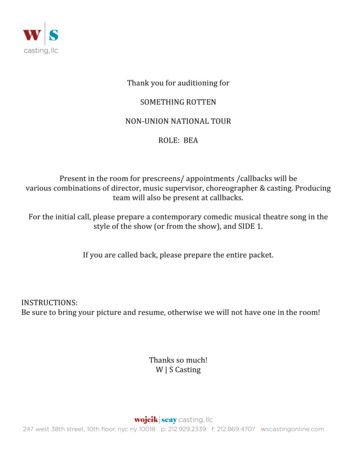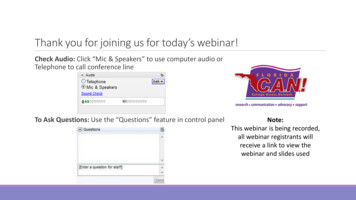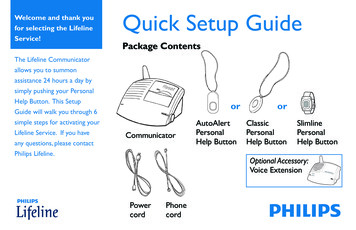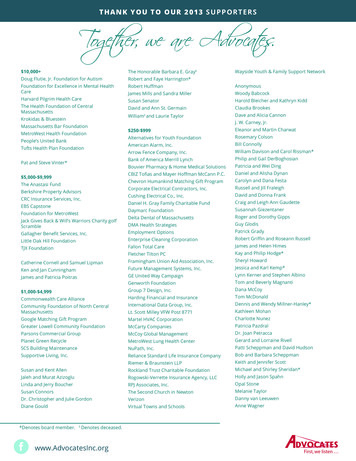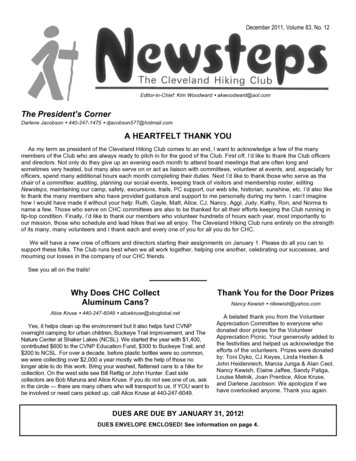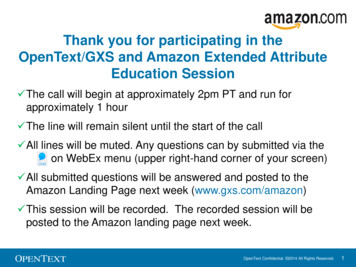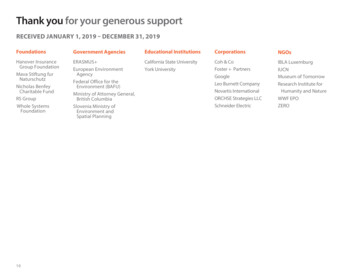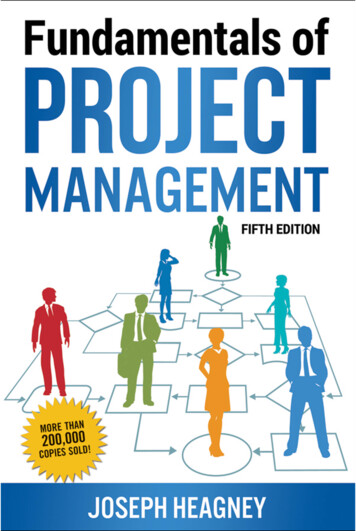
Transcription
Thank you for downloading thisAMACOM eBook.Sign up for our newsletter, AMACOM BookAlert, andreceive special offers, access to free samples,and info on the latest new releases from AMACOM,the book publishing division ofAmerican Management Association.To sign up, visit our website: www.amacombooks.org
Fundamentals ofPROJECTMANAGEMENTFIFTH EDITION
Fundamentals ofPROJECTMANAGEMENTFIFTH EDITIONJOSEPH HEAGNEYAMERICAN MANAGEMENT ASSOCIATIONNew York Atlanta Brussels Chicago Mexico City San Francisco ShanghaiTokyo Toronto Washington, D.C.
To Susan Heagney, my wife and friend for forty years
CONTENTSFigure ListixPreface to the Fifth EditionxiCHAPTER 1An Overview of Project Management1CHAPTER 2The Role of the Project Manager25CHAPTER 3Planning the Project33CHAPTER 4Incorporating Stakeholder Management in the ProjectPlanning Process47CHAPTER 5Developing a Mission, Vision, Goals, and Objectivesfor the Project59CHAPTER 6Creating the Project Risk and Communication Plans69CHAPTER 7Using the Work Breakdown Structure to Plan a Project85CHAPTER 8Scheduling Project Work103CHAPTER 9Producing a Workable Schedule115CHAPTER 10Project Control and Evaluation133
CHAPTER 11The Change Control Process147CHAPTER 12Project Control Using Earned Value Analysis161CHAPTER 13Managing the Project Team175CHAPTER 14The Project Manager as Leader187CHAPTER 15Closing the Project199CHAPTER 16How to Make Project Management Work inYour Company209Acknowledgments215Answers to Exercises217About the Authors221Index223Free Sample Chapter from Emotional Intelligence forProject Managers by Anthony Mersino228About Amacom250
FIGURE LIST1-1. Triangles showing the relationships among P, C, T, and S.1-2. Life cycle of a troubled project.1-3. Appropriate project life cycle.1-4. The steps in managing a project.3-1. Two pain curves in a project over time.3-2. Planning is answering questions.4-1. The stakeholder grid.4-2. The Stakeholder Engagement Assessment Matrix.4-3. Audience guide to knowledge and communication.4-4. The five cultural dimensions.5-1. Chevron showing mission, vision, and problem statement.5-2. Risk analysis example.6-1. Risk matrix.6-2. Risk register.6-3. Communication plan.7-1. WBS diagram to clean a room.7-2. WBS level names.7-3. Partial WBS.7-4. Responsibility chart.7-5. Human productivity.7-6. Time, cost, resource trade-off.7-7. Calculating the standard average.7-8. Calculating the PERT weighted average.8-1. Bar chart.8-2. Arrow diagrams.8-3. WBS to do yard project.[ ix ]
[x]fig ur e li st8-4. CPM diagram for yard project.8-5. WBS to clean room.9-1. Network to illustrate computation methods.9-2. Diagram with EF times filled in.9-3. Diagram showing critical path.9-4. Bar chart schedule for yard project.9-5. Schedule with resources overloaded.9-6. Schedule using float to level resources.9-7. Schedule with inadequate float on C to permit leveling.9-8. Schedule under resource-critical conditions.9-9. Network for exercise.11-1. Triple constraints triangle.11-2. Project change control form.11-3. Project change control log.12-1. BCWS curve.12-2. Bar chart schedule illustrating cumulative spending.12-3. Cumulative spending for the sample bar chart.12-4. Plot showing project behind schedule and overspent.12-5. Project ahead of schedule, spending correctly.12-6. Project is behind schedule but spending correctly.12-7. Project is ahead of schedule and underspent.12-8. Percentage complete curve.12-9. Earned value report.14-1. Leadership style and alignment.15-1. Lessons-learned analysis.15-2. Project closure checklist.15-3. Early termination/cancellation chart.A-1. WBS for the camping trip.A-2. Solution to the WBS exercise.A-3. Solution to the scheduling exercise.
PREFACE TO THE FIFTH EDITIONFour years have passed since the Fourth Edition of this book waspublished, and some important indicators in the project management world have changed, while others have remained thesame. According to the recent Project Management Institute (PMI )“Pulse of the Profession” report, the percentage of projects succeeding(meeting their goals) has remained flat at 64 percent between 2012 and2015. However, today, high-performing organizations are focusing onthe fundamental aspects of culture, talent, and process that supportsuccessful projects. These organizations drive project managementand meet original project goals and business intent two-and-a-halftimes more often than low performers. The message from this reportis clear: Go back to the basics and lay the foundation for successfulprojects in the future. The Fifth Edition of Fundamentals of ProjectManagement is an excellent tool for you to lay your own foundationfor managing projects and, if appropriate, to continue your journeytoward becoming a seasoned project management professional.Two new chapters have been included in this edition. Stakeholdermanagement was added to the Fifth Edition of the Project Management Body of Knowledge (PMBOK Guide) in 2013 as a new knowledge area, and, as a result, we have added Chapter 4, “IncorporatingStakeholder Management into the Project Planning Process.” Thinkabout how many people and groups assist you as your projects maturethrough the project life cycle. Now think about how many of themare impacted by your project deliverables. These people and groupsare called stakeholders. Do you identify your stakeholders? Do youmanage them from project initiation through closure? Many projectmanagers do not, and their results reflect it. This chapter offers bestpractices, tools, and techniques that will help you with your stakeholder interactions and management.The other new chapter included in this edition is Chapter 15,“Closing the Project.” Project closure represents the final process ofmanaging a project. Some of the most successful project managers I[ xi ]
[ xii ]pr e fac e to t he fi ft h e d i t i onhave known and observed through the years do everything well exceptmanage project closure. I call this stage of the project the stealth process because it is often overlooked in training and in practice. Thischapter emphasizes the need for all project managers to be disciplinedwhen closing out a project. It stresses the importance of completingproject closure tasks as carefully as you would the tasks necessary tocreate your schedule or budget, and it offers you the tools you can useto be both thorough and efficient as you close out your projects.Numerous other changes have been made to this edition as well. Firstand foremost, Fundamentals of Project Management has been updatedand revised to fully reflect the Fifth Edition of the PMBOK Guide.Enhancements to the new edition include an expanded Chapter6, formerly titled “Creating the Project Risk Plan.” The chapter nowoffers a focus on creating your own communication plan, with anexcellent template that can be adapted as needed. This should be mandatory for any project manager with medium-to large-sized projects.In addition, the new edition contains a more expansive Chapter7, “Using the Work Breakdown Structure to Plan a Project,” whichnow includes additional coverage of estimating in the project environment. Without estimating, you are basically wandering in the wilderness. This chapter presents multiple tools that will help you navigatethat wilderness and develop solid estimates as you plan your project.Also included in this chapter is a focus on the basics of project procurement management.I consider project management to be the ultimate business paradox.The fundamental project tools never really change, but the nuances ofapplying those tools for project success seem to be always changing,adjusting for the new now. Adjustments must be made for technologicaladvances, workplace demographics, global reach, and even fluctuationsin the economy, to name but a few. Successful project management canbe a real challenge, and it is never dull, which is why I chose it as a career.This new edition of Fundamentals of Project Management includes timeproven tools, as well as information that will keep you current with therequirements of the profession today. As you read, remind yourself tolearn from the past—and look to the future.Joseph J. HeagneyNovember 2015
C H A P T ER 1AN OVERVIEW OF PROJECT MANAGEMENTWhat’s all the fuss about, anyway? Since the first edition ofthis book was published, in 1997, the Project ManagementInstitute (PMI) has grown from a few thousand members tonearly 462,000 in 2015. For those of you who don’t know, PMI is theprofessional organization for people who manage projects. You canget more information from the institute’s website, www.pmi.org. Inaddition to providing a variety of member services, a major objectiveof PMI is to advance project management as a profession. To do so, ithas established a certification process whereby qualifying individualsreceive the Project Management Professional (PMP ) designation. Todo so, such individuals must have work experience (approximately5,000 hours) and pass an online exam that is based on the ProjectManagement Body of Knowledge (PMBOK Guide).A professional association? Just for project management? Isn’tproject management just a variant on general management?Yes and no. There are a lot of similarities, but there are enough differences to justify treating project management as a discipline separatefrom general management. For one thing, projects are more scheduleintensive than most of the activities that general managers handle.And the people in a project team often don’t report directly to theproject manager, whereas they do report to most general managers.[1]
[2]FUND AMENTALS O F PR O JECT MANAGEM ENTSo just what is project management, and, for that matter, what is aproject? PMI defines a project as “a temporary endeavor undertakento create a unique product, service, or result” (PMBOK Guide, PMI,2013, p. 5). This means that a project is done only one time. If it isrepetitive, it’s not a project. A project should have definite startingand ending points (time), a budget (cost), a clearly defined scope—ormagnitude—of work to be done, and specific performance requirements that must be met. I say “should” because seldom does a projectconform to the desired definition. These constraints on a project, bythe way, are referred to throughout this book as the PCTS (performance, cost, time, scope) targets.PMI defines a project as “a temporary endeavorundertaken to produce a unique product, service,or result.”Dr. J. M. Juran, the late quality management guru, also definesa project as a problem scheduled for solution. I like this definitionbecause it reminds me that every project is conducted to solve somekind of problem for a company. However, I must caution that theword “problem” typically has a negative meaning, and projects dealwith both positive and negative kinds of problems. For example,developing a new product is a problem but a positive one, while anenvironmental cleanup project deals with a negative kind of problem.“A project is a problem scheduled for solution.”—J. M. JURANProject FailuresCurrent studies indicate mixed results regarding project management success rates. The Standish Group’s recent Chaos report, witha focus on software development projects, indicates a 29 percentsuccess rate, with 52 percent challenged, and 19 percent failed. Itshould be noted that success factors have been “modernized” to
AN O V ERV IEW OF PROJ ECT MANAGE M E NT[3]mean on time, on budget, and with a satisfactory result. The success rate is virtually unchanged from the 2011 report. Standish doesemphasize that smaller projects have a much higher success ratethan larger ones. Gartner, an IT research and advisory company,echoed these findings with recent reports that larger projects (thosewith budgets exceeding 1 million) have higher failure rates, hoveringaround 28 percent.Most telling were the data recently reported by the Project Management Institute. PMI consistently measures the state of project,program, and portfolio management. Their 2015 “Pulse of the Profession” study reveals some positive trends but also indicates the percentage of projects meeting their goals has remained flat at 64 percentsince 2012. To effect improvement, PMI suggests that organizationsgo back to fundamentals. The three basic areas cited are:1. Culture. Work to create a project management mind-set.2. Talent. Focus on talent management, continuous training,and formal knowledge transfer.3. Process. Support project management through the establishment and adoption of standardized project practices andprocesses.My own survey, based on 28 years of project management, bestpractice identification, project consulting, and training, reveals thatthe more things change, the more they stay the same. Not enoughplanning is being accomplished. Large or small, software, R&D, oradministrative, successful projects rely on good planning. Too manyproject managers take a ready-fire-aim approach in an attempt tocomplete a project quickly. Many organizations do not allow projectmanagers significant planning time or virtually any time at all. Thisoften results in spending far more time and effort reworking errors,soothing unhappy stakeholders, and backing out of blind alleys. Inshort, the lack of adequate planning causes projects to fail.The PMI survey states that “it is time for organizations to revisit thefundamentals of project management and, essentially, go back to thebasics” (p. 4). I could not agree more. You, the reader, must lay yourfoundation and understand the basics presented here to ensure improvement and success as you move forward and manage your projects.
[4]FUND AMENTALS O F PR O JECT MANAGEM ENTWhat Is Project Management?The PMBOK Guide definition of project management is the “application of knowledge, skills, tools, and techniques to project activities tomeet the project requirements. Project management is accomplishedthrough the application and integration of the 47 logical
in the economy, to name but a few. Successful project management can be a real challenge, and it is never dull, which is why I chose it as a career. This new edition of Fundamentals of Project Management includes time-proven tools, as well as information that will keep you current with the requirements of the profession today. As you read .
